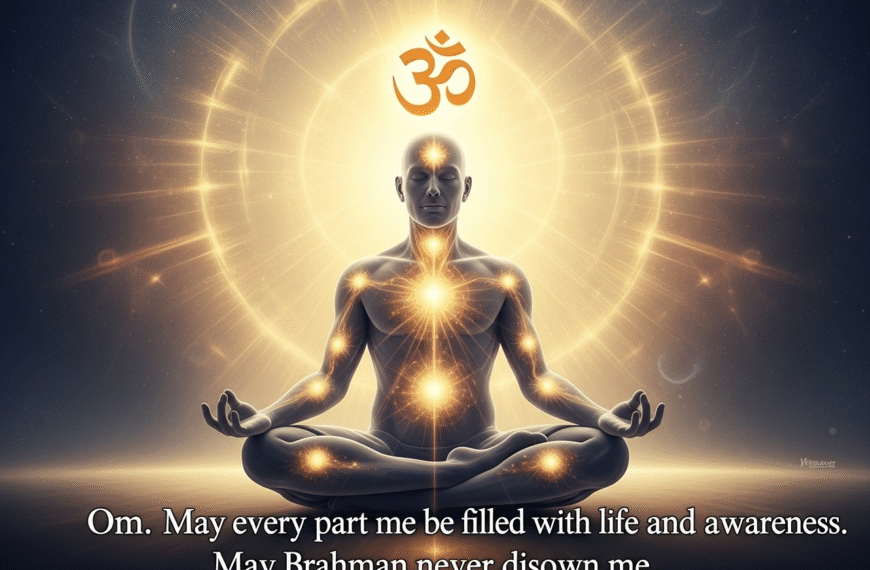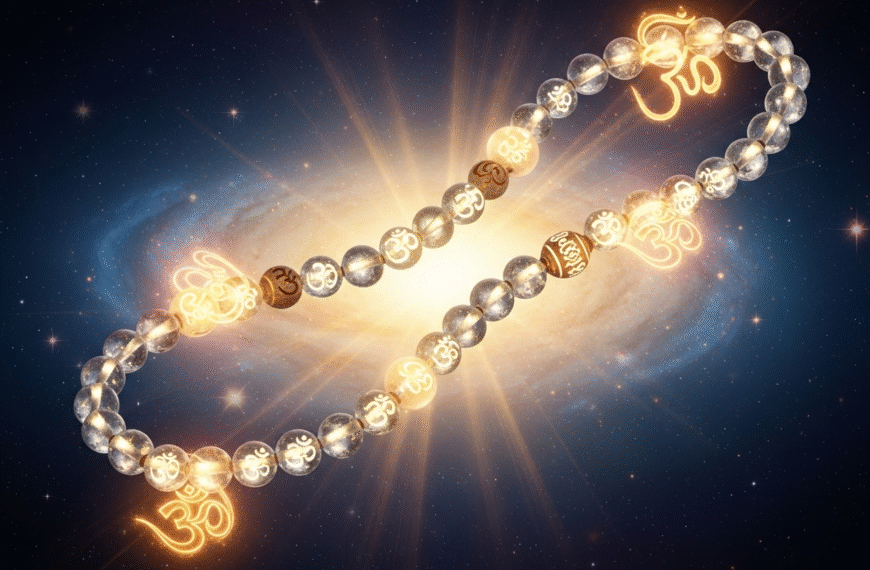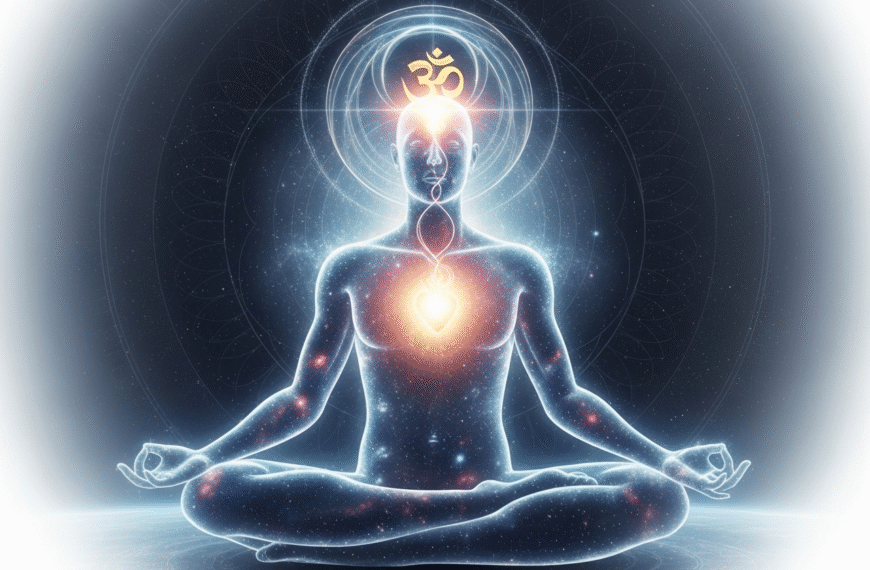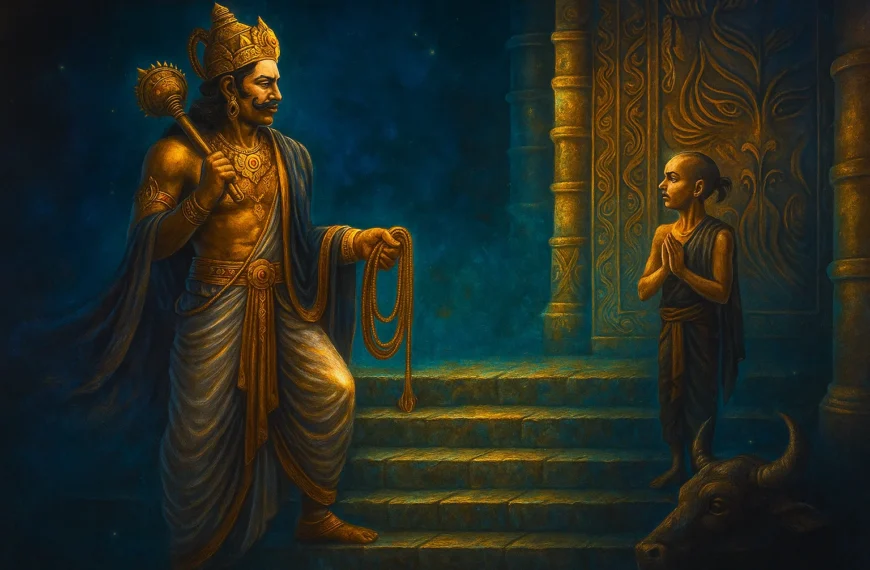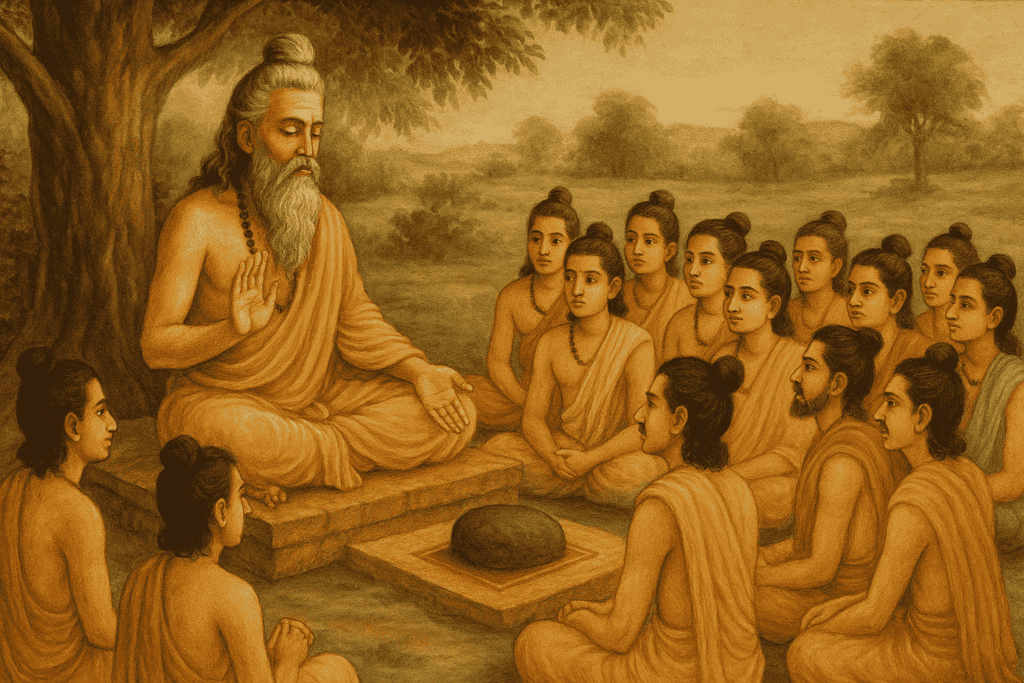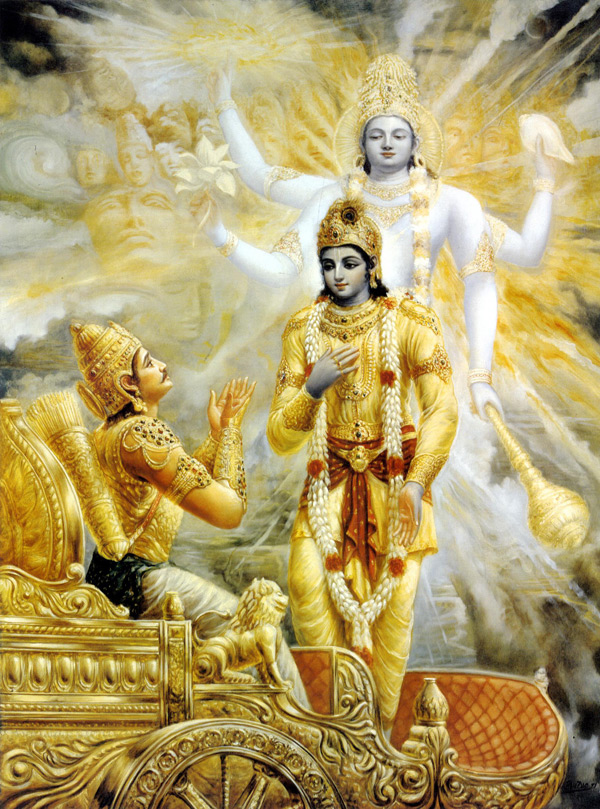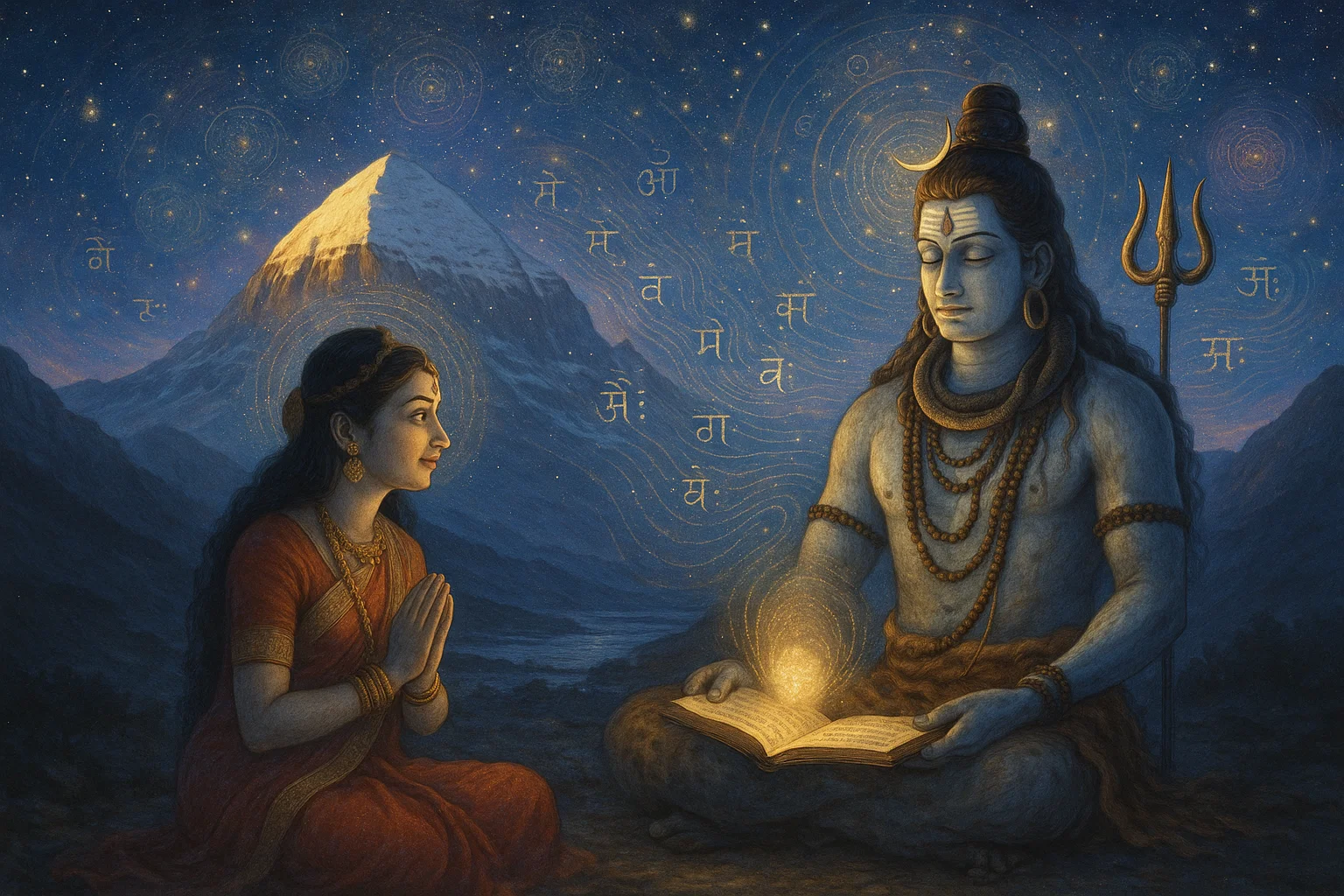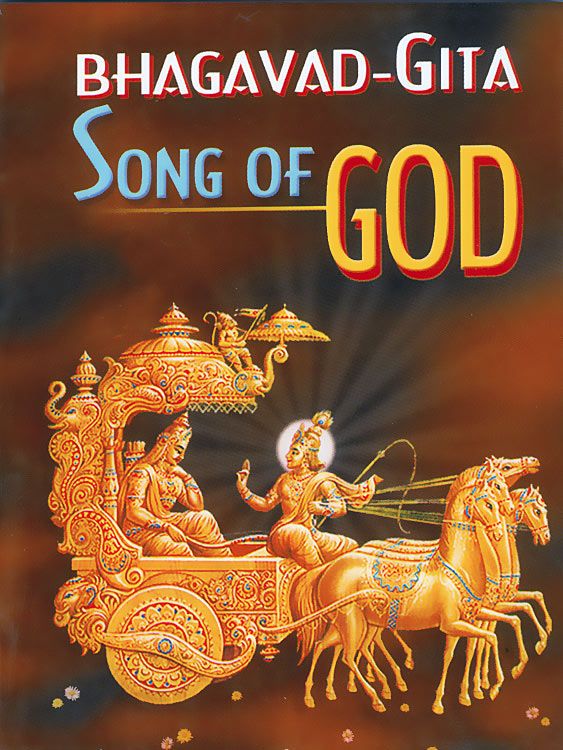The ancient wisdom of the Isavasya Upanishad opens with a profound declaration, a resonant chord that echoes the very essence of existence:
Om! That is full; this is full, (for) from the full the full (indeed) arises. When the full is taken from the full, what remains is full indeed. Om! Peace! Peace! Peace!
ॐ पूर्णमदः पूर्णमिदं पूर्णात्पूर्णमुदच्यते ।
पूर्णस्य पूर्णमादाय पूर्णमेवावशिष्यते ॥
ॐ शान्तिः शान्तिः शान्तिः ॥
oṃ pūrṇamadaḥ pūrṇamidaṃ pūrṇāt pūrṇamudacyate |
pūrṇasya pūrṇamādāya pūrṇamevāvaśiṣyate ||
oṃ śāntiḥ śāntiḥ śāntiḥ ||
Om! That is full; this is full, (for) from the full the full (indeed) arises. When the full is taken from the full, what remains is full indeed. Om! Peace! Peace! Peace!
This timeless invocation speaks to the inherent completeness of all reality. It reminds us that the source of everything, the Absolute (That), is infinite and whole. And from this boundless wholeness, the manifest universe (this) emerges, equally full and perfect. The wonder lies in the understanding that even when the entirety of creation unfolds from the source, the source itself remains undiminished, perpetually full, forever complete. This fundamental truth invites us to perceive an underlying unity and an endless wellspring of being. It ushers in a state of profound tranquility, a peace that transcends individual, collective, and cosmic disturbances – Om Shanti, Shanti, Shanti.
1. Om. All this should be covered by the Lord, whatsoever moves on the earth. By such a renunciation protect (thyself). Covet not the wealth of others.
ईशा वास्यमिदं सर्वं यत्किञ्च जगत्यां जगत् ।
तेन त्यक्तेन भुञ्जीथा मा गृधः कस्यस्विद्धनम् ॥ १ ॥
īśā vāsyamidaṃ sarvaṃ yatkiñca jagatyāṃ jagat |
tena tyaktena bhuñjīthā mā gṛdhaḥ kasya sviddhanam || 1 ||
- All this, whatsoever moves on the earth, should be covered by the Lord. Protect (thyself) by such renunciation. Covet not the wealth of others.
This profound verse invites us to perceive the divine essence permeating every single aspect of existence, every fleeting movement, every vibrant life form on this vast earth. To “cover all this by the Lord” is to infuse our perception with sacredness, recognizing the immanent presence of the Supreme Being in every atom and every experience. Through this conscious awareness, a profound spiritual liberation arises – not by abandoning the world, but by renouncing our clinging attachment to its transient forms. This is the true protection, a shield against the endless cycle of craving and disappointment. When we see the divine in all, the urge to “covet not the wealth of others” naturally dissipates, replaced by an abiding contentment and a deeper reverence for the universal order.
2. By performing karma in this world (as enjoined by the scriptures) should one yearn to live a hundred years. Thus action does not bind thee, the doer. There is no other way than this.
कुर्वन्नेवेह कर्माणि जिजीविषेच्छतं समाः ।
एवं त्वयि नान्यथेतोऽस्ति न कर्म लिप्यते नरे ॥ २ ॥
kurvann eveha karmāṇi jijīviṣecchataṃ samāḥ |
evaṃ tvayi nānyatheto’sti na karma lipyate nare || 2 ||
- By performing karma in this world (as enjoined by the scriptures) should one yearn to live a hundred years. Thus action does not bind thee, the doer. There is no other way than this.
Life is an arena for purposeful action, and the Upanishad encourages us to embrace a full and engaged existence, aspiring to live a long life filled with meaningful deeds. The key, however, lies in the manner of our engagement: performing “karma in this world,” or engaging in our responsibilities and duties, not with a desire for personal gain or a clinging to outcomes, but as an offering, a contribution to the grand cosmic play. When actions are undertaken with this spirit of detachment from results, they lose their power to create karmic bonds that tie us to cycles of rebirth and suffering. This path of selfless engagement is presented as the singular, potent way to live fully without being ensnared by the very actions we undertake.
3. Those worlds of Asuras (demons) are enshrouded by blinding gloom. Those who are the slayers of the Self go to them after death.
असूर्या नाम ते लोका अन्धेन तमसा वृताः ।
ताँस्ते प्रेत्याभिगच्छन्ति ये के चात्महनो जनाः ॥ ३ ॥
asūryā nāma te lokā andhena tamasā vṛtāḥ |
tāṃste pretyābhi gacchanti ye ke cātmahano janāḥ || 3 ||
- Those worlds of Asuras (demons) are enshrouded by blinding gloom. Those who are the slayers of the Self go to them after death.
This verse uses vivid imagery to convey a spiritual truth about the consequences of denying one’s true nature. The “worlds of Asuras” or “demons” are not merely mythical realms, but symbolic states of deep ignorance, spiritual blindness, and inner darkness. Those who are “the slayers of the Self” are not murderers in the ordinary sense, but rather those who, through their actions and mindset, suppress or ignore their inherent divine essence, their true luminous Self. They choose to identify solely with the perishable, the superficial, and the fleeting, thereby plunging themselves into a metaphorical “blinding gloom” – a state of confusion, despair, and alienation from their own inner light, which persists even beyond the physical form.
4. Unmoving, It is one, faster than the mind. The senses cannot reach It, for It proceeds ahead. Remaining static It overtakes others that run. On account of Its presence, Matarsiva (the wind) conducts the activities of beings.
अनेजदेकं मनसो जवीयो नैनद्देवा आप्नुवन्पूर्वमर्षत् ।
तद्धावतोऽन्यानत्येति तिष्ठत्तस्मिन्नपो मातरिश्वा दधाति ॥ ४ ॥
anejad ekaṃ manaso javīyo naitad devā āpnuvan pūrvam arṣat |
tad dhāvato’nyān atyeti tiṣṭhat tasminn apo mātariśvā dadhāti || 4 ||
- Unmoving, It is one, faster than the mind. The senses cannot reach It, for It proceeds ahead. Remaining static It overtakes others that run. On account of Its presence, Matarsiva (the wind) conducts the activities of beings.
Here, the Upanishad attempts to describe the indescribable nature of the ultimate Reality, the Self or Brahman, through powerful paradoxes. This supreme essence is “unmoving,” eternally still and changeless, yet it is simultaneously “faster than the mind,” transcending all mental constructs and conceptual understanding. Our limited “senses cannot reach It” because it is not an object to be perceived, but the very subject of all perception, the foundational consciousness. It “remains static” yet miraculously “overtakes others that run,” implying its omnipresence and that all movement occurs within its stillness. Even the mighty “Matarsiva (the wind),” symbolizing the universal life force and the cosmic breath, conducts the activities of all beings “on account of Its presence,” illustrating that this unmoving Self is the silent, fundamental power behind all cosmic and individual processes.
5. It moves; It moves not. It is far; It is near. It is within all; It is without all.
तदेजति तन्नैजति तद्दूरे तद्वन्तिके ।
तदन्तरस्य सर्वस्य तदु सर्वस्यास्य बाह्यतः ॥ ५ ॥
tad ejati tan naijati tad dūre tad vantike |
tad antarasya sarvasya tad u sarvasyāsya bāhyataḥ || 5 ||
- It moves; It moves not. It is far; It is near. It is within all; It is without all.
The paradox continues, deepening our understanding of the all-encompassing nature of the Absolute. This ultimate Reality simultaneously “moves” as the dynamic force animating the entire universe, yet “moves not” in its essential, unchanging stillness. It appears “far” in its transcendent, infinite nature, beyond our immediate grasp, yet it is intimately “near,” residing as the very core of our being, closer than our own breath. It is “within all” as the inner spirit and consciousness of every creature and object, and simultaneously “without all” as the boundless space, the encompassing void, the ultimate substratum in which everything exists. This verse beautifully captures the unity of the immanent and transcendent, revealing a reality that defies simplistic categorization.
6. He who perceives all beings in the Self alone, and the Self in all beings, does not entertain any hatred on account of that perception.
यस्तु सर्वाणि भूतान्यात्मन्येवानुपश्यति ।
सर्वभूतेषु चात्मानं ततो न विजुगुप्सते ॥ ६ ॥
yastu sarvāṇi bhūtāny ātmany evānupaśyati |
sarvabhūteṣu cātmānaṃ tato na vijugupsate || 6 ||
- He who perceives all beings in the Self alone, and the Self in all beings, does not entertain any hatred on account of that perception.
This verse offers a profound path to liberation from animosity and conflict. When an individual achieves the deep insight to “perceive all beings in the Self alone,” recognizing the shared, singular divine essence within every living creature, and simultaneously sees “the Self in all beings,” understanding that their own deepest reality is universally present, then the very basis for separation and enmity dissolves. Hatred, prejudice, and conflict stem from the illusion of distinction and otherness. With the realization of this inherent unity, the heart expands into boundless compassion and universal love, for how can one hate that which is fundamentally oneself?
7. When a man realises that all beings are but the Self, what delusion is there, what grief, to that perceiver of oneness?
यस्मिन्सर्वाणि भूतान्यात्मैवाभूद्विजानतः ।
तत्र को मोहः कः शोक एकत्वमनुपश्यतः ॥ ७ ॥
yasmin sarvāṇi bhūtāny ātmaivābhūd vijānataḥ |
tatra ko mohaḥ kaḥ śoka ekatvam anupaśyataḥ || 7 ||
- When a man realises that all beings are but the Self, what delusion is there, what grief, to that perceiver of oneness?
Building upon the previous insight, this verse reveals the liberating consequences of recognizing the non-dual reality. When a person profoundly understands that “all beings are but the Self,” meaning that the true essence of every individual and every part of the cosmos is one and the same ultimate consciousness, then the illusions that plague human existence begin to crumble. What can cause “delusion” when one sees through the transient nature of forms to the eternal substratum? What can bring “grief” when one realizes that true self is indestructible and beyond loss, and that separation is merely an appearance? This “perception of oneness” eradicates the root causes of suffering, leading to an abiding state of joy, peace, and fearlessness.
8. That (Self) is all-pervading, radiant, bodiless, soreless, without sinews, pure, untainted by sin, the all-seer, the lord of the mind, transcendent and self-existent. That (Self) did allot in proper order to the eternal Prajapatis known as samvalsara (year) their duties.
स पर्यगाच्छुक्रमकायमव्रणमस्नाविरं शुद्धमपापविद्धम् ।
कविर्मनीषी परिभूः स्वयम्भूयाथातथ्यतोऽर्थान् व्यदधाच्छाश्वतीभ्यः समाभ्यः ॥ ८ ॥
sa paryagācchukram akāyam avraṇam asnāviram śuddham apāpa viddham |
kavir manīṣī paribhūḥ svayambhūr yāthātathyato’rthān vyadadhācchāśvatībhyaḥ samābhyaḥ || 8 ||
- That (Self) is all-pervading, radiant, bodiless, soreless, without sinews, pure, untainted by sin, the all-seer, the lord of the mind, transcendent and self-existent. That (Self) did allot in proper order to the eternal Prajapatis known as samvalsara (year) their duties.
This verse offers a majestic description of the ultimate Self, the Brahman, emphasizing its supreme nature. It is “all-pervading,” stretching limitlessly throughout all space and time; “radiant,” a pure, self-luminous consciousness; “bodiless, soreless, without sinews,” signifying its transcendence of all physical limitations, pain, or imperfection. It is inherently “pure, untainted by sin,” eternally pristine and untouched by any imperfection or moral failing. As “the all-seer,” it is the ultimate consciousness that witnesses everything, and as “the lord of the mind,” it is the ultimate controller and source of all mental faculties. It is “transcendent” (beyond all limitation) and “self-existent” (requiring nothing for its being). Furthermore, this divine Self is the cosmic orchestrator, having meticulously “allotted in proper order to the eternal Prajapatis known as samvalsara (year) their duties,” implying that it is the ultimate source of cosmic laws, cycles, and the very fabric of time, meticulously establishing the universal order and purpose within creation.
9. Those who worship avidya (karma born of ignorance) go to pitch darkness, but to a greater darkness than this go those who are devoted to Vidya (knowledge of the Devatas).
अन्धं तमः प्रविशन्ति येऽविद्यामुपासते ।
ततो भूय इव ते तमो य उ विद्यायां रताः ॥ ९ ॥
andhaṃ tamaḥ praviśanti ye’vidyām upāsate |
tato bhūya iva te tamo ya u vidyāyāṃ ratāḥ || 9 ||
- Those who worship avidya (karma born of ignorance) go to pitch darkness, but to a greater darkness than this go those who are devoted to Vidya (knowledge of the Devatas).
This verse introduces a profound paradox, warning against incomplete paths. “Avidya” here refers to ritualistic actions and worldly duties performed without the ultimate knowledge of the Self, actions driven by a limited understanding of reality or desire for temporary outcomes. Those who exclusively pursue these, without deeper spiritual insight, remain confined to a metaphorical “pitch darkness” – a state of material existence lacking ultimate spiritual illumination. Yet, the verse states that those “devoted to Vidya” – referring to knowledge of specific deities, ritualistic worship, or even intellectual understanding that does not culminate in Self-realization – go to an even “greater darkness.” This suggests that a partial or limited spiritual knowledge, if it fosters spiritual pride or diverts one from the ultimate truth, can be more dangerous than simple ignorance, as it creates a subtle but potent veil over the true, complete understanding.
10. Different indeed, they say, is the result (attained) by vidya and different indeed, they say, is the result (attained) by avidya. Thus have we heard from the wise who had explained it to us.
अन्यदेवाहुर्विद्ययाऽन्यदाहुरविद्यया ।
इति शुश्रुम धीराणां ये नस्तद्विचचक्षिरे ॥ १० ॥
anyad evāhur vidyayā’nyad āhur avidyayā |
iti śuśruma dhīrāṇāṃ ye nas tad vicacakṣire || 10 ||
- Different indeed, they say, is the result (attained) by vidya and different indeed, they say, is the result (attained) by avidya. Thus have we heard from the wise who had explained it to us.
The ancient sages, the “wise who had explained it to us,” clarify that pursuing only “vidya” (limited spiritual knowledge or deity worship) yields a certain outcome, perhaps heavenly abodes or temporary bliss, distinct from the results of pursuing “avidya” (worldly actions and ritualistic duties), which might lead to material prosperity or specific karmic benefits. Neither path, when pursued exclusively, leads to ultimate liberation, highlighting that both have their specific, but limited, consequences. This sets the stage for the crucial synthesis that follows.
11. He who knows both vidya and avidya together, transcends mortality through avidya and reaches immortality through vidya.
विद्यां चाविद्यां च यस्तद्वेदोभयं सह ।
अविद्यया मृत्युं तीर्त्वा विद्ययाऽमृतमश्नुते ॥ ११ ॥
vidyāṃ cāvidyāṃ ca yas tad vedobhayaṃ saha |
avidyayā mṛtyuṃ tīrtvā vidyayā’mṛtam aśnute || 11 ||
- He who knows both vidya and avidya together, transcends mortality through avidya and reaches immortality through vidya.
This is the core insight regarding action and knowledge. True liberation and ultimate fulfillment come not from choosing one path over the other, but from harmoniously integrating “vidya” and “avidya.” One “transcends mortality through avidya” by performing all actions and duties in the world with detachment, selflessness, and without personal attachment to their results. This purifies the mind, prepares the spiritual ground, and liberates one from the binding effects of karma, thereby making the individual fit for higher knowledge. Simultaneously, one “reaches immortality through vidya” by cultivating the supreme knowledge of the Self, understanding one’s true, eternal nature, which ultimately transcends all temporal limitations and leads to union with the Absolute, the state of immortality.
12. To pitch darkness they go who worship the Unmanifested (Prakriti). To a greater darkness than this go those who are devoted to the Manifested (Hiranyagarbha).
अन्धं तमः प्रविशन्ति येऽसम्भूतिमुपासते ।
ततो भूय इव ते तमो य उ सम्भूत्यां रताः ॥ १२ ॥
andhaṃ tamaḥ praviśanti ye’sambhūtim upāsate |
tato bhūya iva te tamo ya u sambhūtyāṃ ratāḥ || 12 ||
- To pitch darkness they go who worship the Unmanifested (Prakriti). To a greater darkness than this go those who are devoted to the Manifested (Hiranyagarbha).
Similar to the Vidya-Avidya dynamic, this verse addresses the paths of focusing solely on the unmanifest or the manifest aspects of reality. Those who exclusively “worship the Unmanifested” – referring to the formless, undifferentiated primal nature (Prakriti) or abstract concepts without integrating them with the experienced world – risk losing their way in a metaphorical “pitch darkness” of abstraction, unable to fully engage with life. Paradoxically, those “devoted to the Manifested” – the world of forms, names, and sensory experiences, symbolized by Hiranyagarbha, the cosmic intelligence or first manifestation – go to an even “greater darkness.” This suggests that getting solely entangled in the fleeting, perishable forms of the world, without recognizing the unmanifest substratum, leads to deeper delusion and suffering. Both extremes are incomplete and can lead to spiritual stagnation.
13. Different indeed, they say, is the result (attained) by the worship of the Manifested and different indeed, they say, is the result (attained) by the worship of the Unmanifested. Thus have we heard from the wise who had explained it to us.
अन्यदेवाहुः सम्भवादन्यदाहुरसम्भवात् ।
इति शुश्रुम धीराणां ये नस्तद्विचचक्षिरे ॥ १३ ॥
anyad evāhuḥ sambhavād anyad āhur asambhavāt |
iti śuśruma dhīrāṇāṃ ye nas tad vicacakṣire || 13 ||
- Different indeed, they say, is the result (attained) by the worship of the Manifested and different indeed, they say, is the result (attained) by the worship of the Unmanifested. Thus have we heard from the wise who had explained it to us.
Again, the ancient seers clarify that engaging solely with the “Manifested” world (e.g., through rituals focused on worldly outcomes, or intense attachment to sensory experiences) yields specific, temporary results. Likewise, exclusive focus on the “Unmanifested” (e.g., pure contemplation or abstract philosophical pursuits devoid of practical application) brings different, but equally limited, outcomes. Each path, in isolation, falls short of the complete truth, and this distinction has been faithfully transmitted through generations of “wise” teachers.
14. He who knows both the Unmanifested and the destructible (Hiranyagarbha) together, transcends death by the (worship of) the destructible and attains immortality by the (worship of ) the Unmanifested.
सम्भूतिं च विनाशं च यस्तद्वेदोभयं सह ।
विनाशेन मृत्युं तीर्त्वा सम्भूत्यामृतमश्नुते ॥ १४ ॥
sambhūtiṃ ca vināśaṃ ca yas tad vedobhayaṃ saha |
vināśena mṛtyuṃ tīrtvā sambhūtyāmṛtam aśnute || 14 ||
- He who knows both the Unmanifested and the destructible (Hiranyagarbha) together, transcends death by the (worship of) the destructible and attains immortality by the (worship of ) the Unmanifested.
This verse provides the harmonious synthesis for navigating the manifest and unmanifest dimensions of reality. To truly progress spiritually, one must understand “both the Unmanifested and the destructible” (the manifest world, including Hiranyagarbha, which is subject to change and dissolution). By engaging with and navigating “the destructible” world of forms and experiences – performing one’s duties, interacting with creation – without attachment and with an understanding of its impermanence, one “transcends death” in the sense of escaping the cycle of rebirth driven by ignorance. Concurrently, by focusing on and realizing “the Unmanifested” – the eternal, formless, absolute Reality that underlies all existence – one “attains immortality,” realizing their true, timeless, and boundless Self. This integration ensures a holistic spiritual journey, where one is active in the world yet rooted in the eternal.
15. The face of the Truth (ie., Purusha in the solar orb) is veiled by a bright vessel. Mayst thou unveil it, O Sun, so as to be perceived by me whose dharma is truth.
हिरण्मयेन पात्रेण सत्यस्यापिहितं मुखम् ।
तत्त्वं पूषन्नपावृणु सत्यधर्माय दृष्टये ॥ १५ ॥
hiraṇmayena pātreṇa satyasyāpihitaṃ mukham |
tat tvaṃ pūṣann apāvṛṇu satyadharmāya dṛṣṭaye || 15 ||
- The face of the Truth (ie., Purusha in the solar orb) is veiled by a bright vessel. Mayst thou unveil it, O Sun, so as to be perceived by me whose dharma is truth.
As the seeker approaches the culmination of their journey, a heartfelt prayer arises. The “face of the Truth,” representing the ultimate divine reality, the Purusha, is perceived as being “veiled by a bright vessel.” This “bright vessel” can be understood as the dazzling, captivating nature of the material world, the limitations of sensory perception, or even the brilliance of intellectual knowledge that, while illuminating, can still obscure the direct, intuitive grasp of absolute Truth. The prayer is addressed to “O Sun,” symbolizing the source of all light, consciousness, and the cosmic intellect, imploring it to “unveil” the ultimate reality. This unveiling is sought specifically by one “whose dharma is truth,” indicating a soul dedicated to righteousness and committed to living in alignment with cosmic order, making them worthy of such profound revelation.
16. O nourisher, pilgrim of the solitude, controller, absorber (of all rasas), offspring of Prajapati, cast away thy rays, gather them up and give up thy radiating brilliance. That form of thine, most graceful, I may behold. He, the Purusha (in the solar orb), I am.
पूषन्नेकर्षे यम सूर्य प्राजापत्य व्यूह रश्मीन्समूह ।
तेजः यत्ते रूपं कल्याणतमं तत्ते पश्यामि योऽसावसौ पुरुषः सोऽहमस्मि ॥ १६ ॥
pūṣann ekarṣe yama sūrya prājāpatya vyūha raśmīn samūha |
tejaḥ yatte rūpaṃ kalyāṇatamaṃ tat te paśyāmi yo’sāv asau puruṣaḥ so’ham asmi || 16 ||
- O Sun, sole traveller of the Heavens, controller of all, Surya, son of Prajapati remove thy rays and gather up thy burning light. I behold thy glorious form; I am he, the Purusha within thee.
This verse continues the intimate invocation to the Sun, recognizing its multifaceted roles as “nourisher” of life, “pilgrim of the solitude” (traveling the vastness of space), “controller” of cosmic forces, and “absorber of all rasas” (essence of existence), and ultimately “offspring of Prajapati” (the creator). The plea is for the Sun to “cast away thy rays, gather them up and give up thy radiating brilliance,” not to cease shining, but to temper its overwhelming luminosity, allowing the seeker to perceive the subtle, inner essence that lies beyond the blinding glare of the phenomenal world. The desire is to behold “That form of thine, most graceful,” which is the very form of Truth itself. The prayer culminates in the ultimate, transformative realization, the non-dual truth: “He, the Purusha (in the solar orb), I am.” The individual consciousness merges with the cosmic consciousness, recognizing its inherent oneness with the divine.
17. Let (my) vital air (prana) now attain the immortal Air (all-pervading Self); then let this body be reduced to ashes. Om, O mind, remember – remember that which has been done, O mind, remember – remember that which has been done.
वायुरनिलममृतमथेदं भस्मान्तं शरीरम् ।
ॐ क्रतो स्मर कृतं स्मर क्रतो स्मर कृतं स्मर ॥ १७ ॥
vāyur anilam amṛtam athedaṃ bhasmāntaṃ śarīram |
oṃ krato smara kṛtaṃ smara krato smara kṛtaṃ smara || 17 ||
- Let (my) vital air (prana) now attain the immortal Air (all-pervading Self); then let this body be reduced to ashes. Om, O mind, remember – remember that which has been done, O mind, remember – remember that which has been done.
This is a powerful prayer uttered at the threshold of departure from the physical realm, a final aspiration for liberation. The dying individual prays for their “vital air (prana),” the life force that animates the body, to gracefully “attain the immortal Air” – to merge with the boundless, all-pervading, eternal Self, the cosmic consciousness. As this spiritual union is sought, the physical “body” is accepted to be “reduced to ashes,” acknowledging its impermanence and its role as a temporary vessel. The repeated mantra, “Om, O mind, remember – remember that which has been done,” serves as a poignant reminder for the consciousness at the moment of transition. It is a directive to recall not merely past deeds (karma), but more profoundly, the spiritual practices, insights, and the essence of a life lived in pursuit of truth, ensuring that the final journey is guided by wisdom and focused on the ultimate spiritual goal.
18. O Fire, O Deva, knower of all our actions or all our knowledge, lead us by the good path for enjoying the fruits of actions. Liberate us from our deceitful sins. We offer thee ever more our words of adoration.
अग्ने नय सुपथा राये अस्मान्विश्वानि देव वयुनानि विद्वान् ।
युयोध्यस्मज्जुहुराणमेनो भूयिष्ठां ते नम उक्तिं विधेम ॥ १८ ॥
agne naya supathā rāye asmān viśvāni deva vayunāni vidvān |
yuyodhy asmaj juhurāṇam eno bhūyiṣṭhāṃ te nama uktiṃ vidhema || 18 ||
- O Fire, O Deva, knower of all our actions or all our knowledge, lead us by the good path for enjoying the fruits of actions. Liberate us from our deceitful sins. We offer thee ever more our words of adoration.
The final verse is a fervent prayer to Agni, the divine Fire, revered as a purifying force and a messenger to the gods. Addressed as “O Deva,” a divine being, and “knower of all our actions or all our knowledge,” Agni is invoked for guidance on the spiritual journey. The plea is to be “lead us by the good path,” the path of righteousness and spiritual progress, enabling the seeker to experience the true, positive “fruits of actions” – not just material rewards, but the wisdom and purification that arise from righteous living. There is also a humble request to “liberate us from our deceitful sins,” recognizing the lingering effects of past errors and actions driven by ignorance or attachment, which subtly obscure the truth. With profound reverence, the prayer concludes with an offering of “ever more our words of adoration,” a continuous expression of devotion and surrender to the divine power that guides and purifies.
Om! That is full; this is full, (for) from the full the full (indeed) arises. When the full is taken from the full, what remains is full indeed. Om! Peace! Peace! Peace!
ॐ पूर्णमदः पूर्णमिदं पूर्णात्पूर्णमुदच्यते ।
पूर्णस्य पूर्णमादाय पूर्णमेवावशिष्यते ॥
ॐ शान्तिः शान्तिः शान्तिः ॥
oṃ pūrṇamadaḥ pūrṇamidaṃ pūrṇāt pūrṇamudacyate |
pūrṇasya pūrṇamādāya pūrṇamevāvaśiṣyate ||
oṃ śāntiḥ śāntiḥ śāntiḥ ||
Om! That is full; this is full, (for) from the full the full (indeed) arises. When the full is taken from the full, what remains is full indeed. Om! Peace! Peace! Peace!
Thus concludes the Isavasya Upanishad, a profound tapestry of wisdom woven from the threads of ancient insight, eternally reminding us of the inherent fullness and peace that is the ultimate reality of existence. It inspires us to live a life of conscious presence, selfless action, and unwavering dedication to the realization of our true, unified Self.

